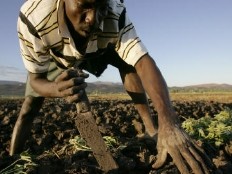|
||||||||||||||||||
|
|
Haiti - Agriculture : Recent projections on the food security 01/10/2011 13:37:53
However, it is necessary to underline that the production will be slightly lower in cereal equivalents compared to a normal year according to a crop assessment conducted by the CNSA. The poor distribution of rainfall resulting in a surplus or a deficit of water at critical moments of crop development is the cause. For example, in many municipalities in the departments of Nord, Plateau Central, South and Artibonite, excess moisture has caused the decline in production of beans. There is also the fact that many farmers have reduced the area planted due to late arrival of the rainy season or the lack of agricultural inputs. With the political transition, very little fertilizers are available in the market causing a price increase of over 100%. Rice farmers in the Artibonite, South, North and Northeast were not able to adequately fertilize their rice fields. If this decline is not compensated by imports, it will help to keep the number of people in food insecurity situation to a higher level than previous years. The assessment of agricultural production made by the CNSA estimates the import requirements to 910 000 tonnes in equivalent cereals between July 2011 and June 2012. With the early harvest, local food prices tend to decline. However, they remain largely above their 2010 level at the same time. In early September, imported rice begins a downward tendency. However, roads may be damaged by the rains of September and October, reducing the volume of trade and resulting in a significant increase of prices as is often the case in this period. HAITI Update of projections of food security September 2011 Metropolitan area of Port-au-Prince (slums and camps) The number of people living in tents after the earthquake of January 12, 2010 is approximately 600,000 according to data from the World Organisation for Migration. Most of them seem to be obliged to remain in the camps even beyond the second anniversary of the earthquake. With the uncertainty in the establishment of a new government, the metropolitan area was the scene of demonstrations of various groups claiming their rights. These demonstrations often degenerate and cause the loss of working days and the decline in the income of the poor. Northwest The Northwest region, particularly the municipalities of Baie de Henne, Bombardopolis and Mole Saint Nicolas, characterized by a strong environmental degradation, was affected by drought over the last two years resulting in low agricultural production. The June rains have encouraged the development of land under cultivation. Although late harvest will be quite good. Between October and December, the situation will improve. North The drought has delayed planting of spring. Harvesting of the spring campaign will be between September and October. La Victoire, Ranquitte and Pignon and are most affected. Coal production and migration to the Dominican Republic are the main strategies used by the poor. An improvement in the food situation is hoped between October and December, during which the poors will pass from the state of crisis to that of precarious. Southeast The situation improved to Côtes de Fer with the purchase of maize from Aquin whose price are lower, about 20 gourds of the pot 6 pounds. Corn planted in the plains of Côtes de Fer will be harvested in October. The execution of some activities of Cash for Works facilitate access of the poor to food. By cons, to Belle-Anse, the beans are lost and the corn production in the plain of Mapou remain low. Between October and December, due to fruit, cereals and other crops to be harvested, the situation of poor households could improve in most municipalities, however Belle-Anse and Grand Gosier remain in crisis. See aslo : https://www.haitilibre.com/en/news-3683-haiti-agriculture-update-on-the-food-safety-until-december-2011.html HL/ HaitiLibre
|
|
|
Why HaitiLibre ? |
Contact us |
Français
Copyright © 2010 - 2024 Haitilibre.com |



